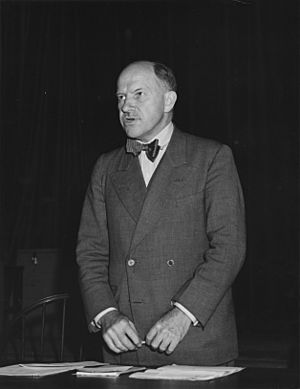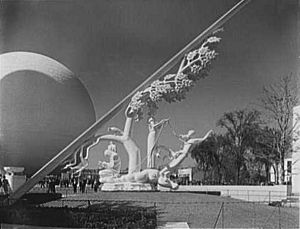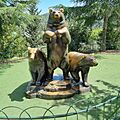Paul Manship facts for kids
Quick facts for kids
Paul Manship
|
|
|---|---|

Paul Manship, Chairman of the New York City Council for Art Week, opens the meeting held Thursday evening, October 16, 1941, at the Architectural League
|
|
| Born | December 24, 1885 St. Paul, Minnesota, U.S.
|
| Died | January 28, 1966 (aged 80) New York, U.S.
|
| Nationality | American |
| Known for | Sculpture |
Paul Howard Manship (born December 24, 1885 – died January 28, 1966) was a famous American sculptor. He was known for creating art that looked like ancient Greek and Roman sculptures. Paul Manship was also a very important artist in the Art Deco art style.
He is famous for his large sculptures found in public places. Two of his most well-known works are Prometheus in Rockefeller Center in New York City and the Celestial Sphere Woodrow Wilson Memorial in Geneva, Switzerland. He also helped design the modern official seal of New York City.
Early in his career, Manship became known for his unique style. He liked simple, flowing lines in his art. He also spent summers with other artists at the Cornish Art Colony in New Hampshire. Later, he created his own art space in Gloucester, Massachusetts. Today, a group called the Manship Artists Residency + Studios works to keep his old home as a place for artists to live and work.
Contents
Paul Manship's Life and Art
His Early Life and Training
Paul Howard Manship was born on December 24, 1885, in St. Paul, Minnesota. His parents were Charles and Mary Manship. Paul was one of seven children in the family. His father worked for a gas company in St. Paul.
Paul Manship started learning art at the St. Paul School of Art in Minnesota. He then moved to Philadelphia to study at the Pennsylvania Academy of Fine Arts. After that, he went to New York City. There, he joined the Art Students League of New York. He learned about human anatomy from George Bridgman and sculpting from Hermon Atkins MacNeil. For a few years, he also worked as an assistant to other sculptors.
In 1909, Paul Manship won the important Rome Prize. This allowed him to study in Rome, Italy, from 1909 to 1912. While in Europe, he became very interested in ancient art. His own sculptures started to look more like old Greek and Roman art. He also became interested in classical sculptures from India. You can see this influence in some of his works, like Dancer and Gazelles. Manship was one of the first artists to study ancient art from places like Egypt and Assyria.
His Amazing Artworks
When Paul Manship returned to America, his art style was popular with many people. His simple lines and details appealed to artists who wanted to try new things. At the same time, his focus on traditional beauty made his art popular with collectors who liked more classic styles. Many people see Manship's work as an early example of the Art Deco style.
Manship created over 700 sculptures during his career. He often had talented assistants help him. Some of these assistants, like Gaston Lachaise and Leo Friedlander, later became famous sculptors themselves.
Even though he wasn't mainly a portrait artist, Manship made statues and busts of important people. These included Theodore Roosevelt, John D. Rockefeller, and Robert Frost. Manship was also very good at making low-relief sculptures. He used this skill to design many coins and medals. Some of his famous medal designs include the Dionysus medal and the inaugural medals for presidents Franklin D. Roosevelt and John F. Kennedy. During World War II, he designed medals for the U.S. Merchant Marine.
Manship was also chosen to create monuments after both the First and Second World Wars. These monuments are in military cemeteries in France and Italy. His art was even part of the art competitions at the 1928 Summer Olympics and the 1932 Summer Olympics.
Awards and Connections
For several summers, Manship found friends and artistic inspiration at the Cornish Art Colony in New Hampshire. Many famous sculptors, like Augustus Saint-Gaudens and Daniel Chester French, also visited this colony. Manship felt that 1916 was a very important year for his artistic growth. He was able to show modern ideas using older, more traditional styles.
Paul Manship was involved with many important art groups. He served on the board of the Smithsonian American Art Museum. He was also a member of the National Academy of Design and the American Academy of Arts and Letters. He received many honors for his work. These included the Widener Gold Medal and the French Legion of Honor award.
Today, many of Manship's papers, models, and sculptures are kept at the Smithsonian's Archives of American Art. The Smithsonian even held a special show of his work in 2004. There is also a special gallery at the Smithsonian American Art Museum just for his sculptures.
Paul Manship's son, John Paul Manship, also became an artist.
Museums with Paul Manship's Art
- Addison Gallery of American Art (Andover, Mass.)
- Art Institute of Chicago
- Cape Ann Museum (Gloucester, Mass.)
- Cleveland Museum of Art
- Corcoran Gallery of Art (Washington, D.C.)
- Crystal Bridges Museum of American Art (Bentonville, Ark.)
- Honolulu Museum of Art
- Indianapolis Museum of Art
- Isabella Stewart Gardner Museum (Boston)
- Los Angeles County Museum of Art
- Minneapolis Institute of Arts
- Museum of Fine Arts, Boston
- National Gallery of Art (Washington D.C.)
- New Britain Museum of American Art (Connecticut)
- New Orleans Museum of Art
- Smithsonian American Art Museum (Washington D.C.)
- Toledo Museum of Art (Ohio)
- Walker Art Center (Minneapolis)
Public Sculptures by Paul Manship
- Indian Hunter, Boston
- Earth, Air, Water and Fire, bronze reliefs for the American Telephone & Telegraph Building, New York City, 1914
- Sphinxes, Untermyer Gardens, Yonkers, New York, 1917
- J. Pierpont Morgan Relief Plaque, Metropolitan Museum of Art, New York City, 1920
- Indian Hunter and his Dog, Cochran Park, St. Paul, Minnesota, 1926
- Abraham Lincoln: The Hoosier Youth, Fort Wayne, Indiana, 1932
- Waldo Hutchins bench, a sundial sculpture in Central Park, New York City, 1932
- Paul Rainey Memorial Gateway, Bronx Zoo, New York City, 1934
- Prometheus, Rockefeller Center, New York City, 1934
- Group of Bears, Bronx Zoo, New York City, 1926–39 (also in Central Park and Jerusalem Biblical Zoo)
- Time and the Fates of Man Sundial, 1939 World's Fair, New York City, 1939
- The Celestial Sphere Woodrow Wilson Memorial, United Nations Office, Geneva, Switzerland, 1939
- President Albert Murphree statue, University of Florida, Gainesville, Florida, 1946
- Lehman/Tisch Gateway, Central Park Zoo, New York City, 1961
- Theodore Roosevelt statue, Theodore Roosevelt Island, Washington, D.C., 1967
Images for kids
See also
 In Spanish: Paul Manship para niños
In Spanish: Paul Manship para niños










